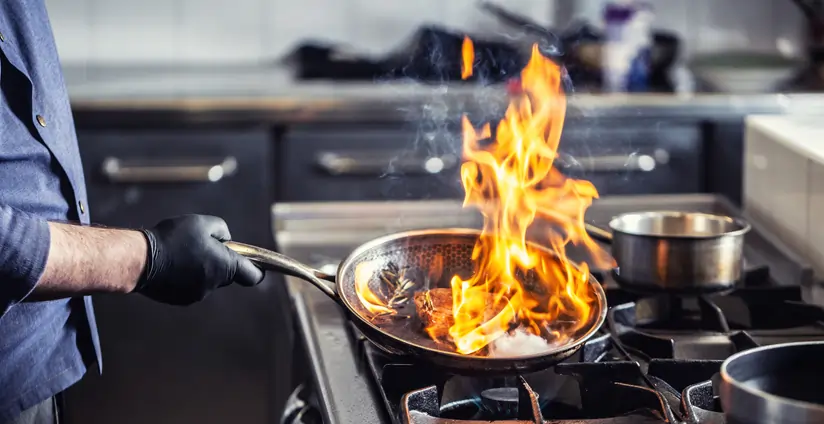
By Jeff Leitman Hell’s Kitchen Cookware
Cooking is a daily ritual for many, and the cookware you use can greatly affect the quality, ease, and enjoyment of meal preparation.
With an overwhelming array of options available, selecting the right cookware can be daunting. Let’s explore the factors to consider when choosing cookware, including frequency of use, overall performance, durability, nonstick properties, and the role of cost. We will also take a look at the latest hybrid cookware and the benefits of tri-clad construction.
Frequency of Usage
One of the most crucial factors to consider when choosing your “tools of the trade” is how often you cook. If you engage in a daily cooking routine, investing in high-quality, durable cookware would be a wise choice. For those who cook less frequently or are just starting to hone their culinary skills, a basic set might be more appropriate and cost-effective.
Type of Cooking
Think about what you cook frequently, because this will influence your choice of pots and pans. For example, if you sear meat often, a cast-iron skillet facilitates even browning. Nonstick frying pans are best for scrambled eggs, pancakes, and even delicate foods such as fish. And stainless is perfect for virtually any food that needs searing or browning.
Thick, heavy cast iron holds on to heat more effectively than thinner stainless steel or aluminum, which makes it ideal for searing and high-temperature cooking. But it’s for that same reason that you should pay careful attention when you’re cooking lower-temperature recipes in cast-iron cookware – like eggs, which can overcook quickly since cast iron retains heat and temperature can’t be reduced quickly.
Type of Material
Stainless Steel
- Pros: Durable, non-reactive (won’t change the taste of acidic foods), and resistant to rust and corrosion. Good for browning and braising.
- Cons: Difficult to use and clean if not seasoned or heated properly. Poor heat conductivity unless bonded with aluminum or copper.
Cast Iron
- Pros: Excellent heat retention and distribution. Ideal for searing, frying, and slow cooking. Can be used on the stovetop and in the oven.
- Cons: Heavy, requires seasoning, and not dishwasher safe. Reactive with acidic foods.
Non-Stick (Teflon, Ceramic)
- Pros: Easy to clean, requires less oil for cooking. Good for eggs and pancakes.
- Cons: Can be easily scratched, especially if metal utensils are used. Must be replaced more often as scratches may release particles into food. Teflon can release toxic fumes if overheated.
Copper
- Pros: Best thermal conductivity for precise temperature control.
- Cons: Expensive, reactive with acidic foods, and requires polishing.
Aluminum
- Pros: Excellent heat conductivity and lightweight.
- Cons: Reactive with acidic and alkaline foods. Anodized aluminum is a less reactive option.
Glass & Ceramic
- Pros: Good for baking, doesn’t react with foods.
- Cons: Poor heat conductivity can break if dropped or exposed to temperature shocks.
Balancing Quality and Functionality
When considering cookware, think about the types of dishes you frequently prepare. For versatile cooking options, look for cookware that offers excellent heat distribution and retention. There are a variety of high-quality brands known for their superior performance, but they come with a higher price tag.
Durability: Investing in Longevity
Durability is a key consideration for frequent cooks. Stainless steel and cast iron are known for their longevity. Stainless steel is resilient against rust and corrosion, whereas cast iron, when properly maintained, can last generations. Nonstick pans, while convenient, may have a shorter lifespan and are often less durable under high heat and frequent use. Also, consider the care required for each type of cookware. Stainless steel and non-stick pans require less maintenance compared to cast iron or copper.
Nonstick Properties: Balancing Health and Convenience
Nonstick cookware is popular for its ease of cleaning and the ability to cook with less oil, making it a healthier option. When choosing nonstick, consider PFOA-free options for safety. As noted earlier, keep in mind that nonstick surfaces can deteriorate over time, especially when used at high temperatures or cleaned with abrasive materials.
Balancing Budget with Quality
Cost is a significant factor in cookware selection. High-end brands offer quality and longevity but at a higher price. It’s important to balance your budget with the expected lifespan and performance of the cookware. Cheaper options might save money upfront but may need to be replaced more frequently, resulting in higher cost over the long term.
Hybrid Cookware: The Rise Stainless Laser-Etched Technology
Hybrid cookware, particularly those featuring tri-clad technology, represents the latest innovation in cookware design. These products combine layers of different materials, such as an aluminum core sandwiched between stainless steel, to offer rapid heating, even heat distribution, and durability. They also have a raised steel pattern above a nonstick surface, for versatile performance. Hybrid cookware offers advantages such as:
- Non-Stick performance & Stainless-Steel Durability: The stainless-steel cooking surface has material removed via laser etching process. A reinforced non-stick coating is added into the depressions created from the etching process, combining the benefits of both cookware types.
- Rapid Heating: Tri-clad cookware heats up faster, allowing you to adjust to different cooking temperatures quickly.
- Even Heat Distribution: The aluminum core ensures heat spreads evenly across the surface, preventing hotspots.
- Durability and Versatility: The stainless-steel layers provide robustness and versatility, creating a product that is suitable for multiple cooking methods.
Cost vs. Performance
While hybrid cookware offers excellent cooking performance, the cost should be taken into account. The long-lasting nature of hybrid cookware must be weighed against the shorter lifespan of traditional non-stick cookware. If considering high-end hybrid cookware, reflect on your cooking frequency, the variety of dishes you prepare, and whether the benefits outweigh the cost.
Heat Source Compatibility
- Gas Stoves: Most materials work well but require cookware that can handle quick temperature changes.
- Electric Coil, Glass, or Ceramic Stovetops: Requires flat-bottomed pans for effective heat transfer.
- Induction Cooktops: Need magnetic materials like cast iron or magnetic stainless steel.
- Oven Use: Check the maximum temperature that the cookware can withstand. Some cookware sets include glass lids that cannot handle the same high temperatures as the pots or pans.
Other Factors to Consider
- Weight and Handle Comfort: Heavier cookware can be more durable but harder to handle. Ergonomic handles can make a significant difference.
- Maintenance Requirements: Consider the care needed to maintain the cookware. Some materials require seasoning or special cleaning methods. Many people enjoy cooking, but few enjoy the cleanup.
- Storage: If you don’t have much storage space, consider lighter weight or multi-function cookware. Many brands also have storage-friendly options with interchangeable lids or pots and pans that nest and stack to save space. If you love the look of your cookware, you can save precious cabinet space and leave it out on the stovetop, store it on open shelves, or get creative with cookware hanging racks.
Conclusion
Choosing the right cookware involves a careful assessment of your cooking habits, budget, and the features you value most, like durability, nonstick properties, and ease of maintenance. While high-end options like triclad cookware offer excellent performance, they do come at a higher cost, which must be factored into the final decision.
Ultimately, the best cookware is that which aligns with your cooking style, meets your culinary needs, and fits within your budget. Whether you opt for traditional materials or the latest technology, the right cookware can transform your cooking experience, making it more enjoyable and efficient. Remember, the most suitable cookware is one that you will use frequently and with pleasure, enhancing your daily culinary adventures.
ABOUT THE AUTHOR
Jeff Leitman is the Founder and CEO of Hell’s Kitchen Cookware, a leading cookware brand inspired by the long-running television show. Visit the Hell’s Kitchen Cookware site at https://hellskitchenstore.com/.


